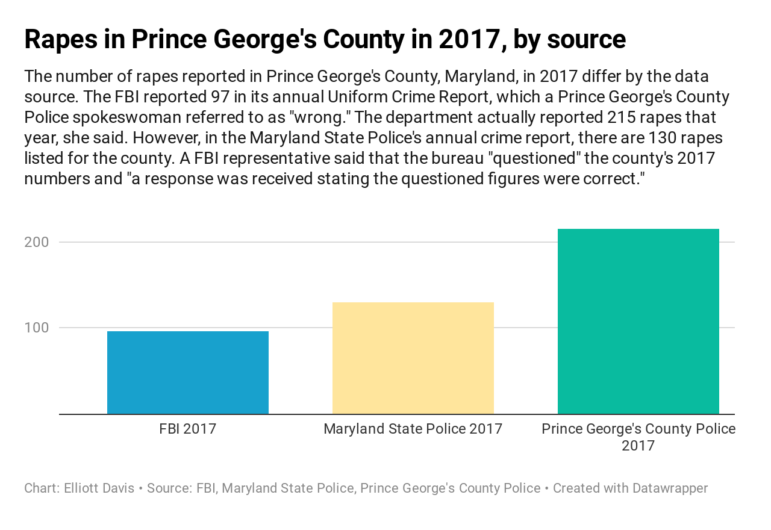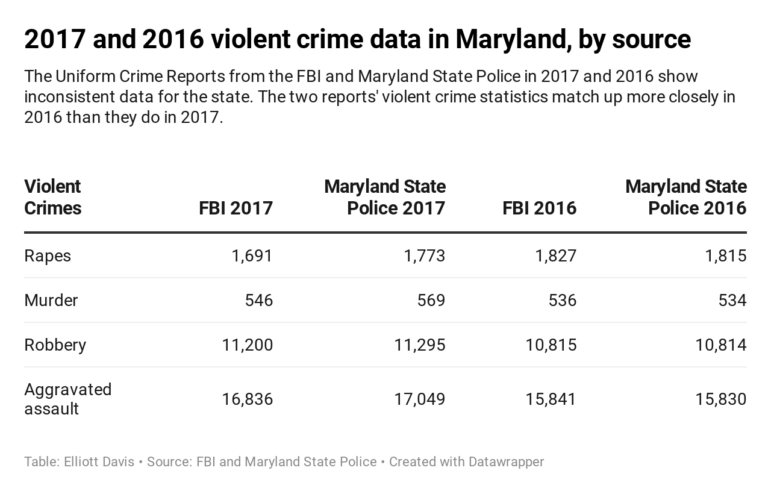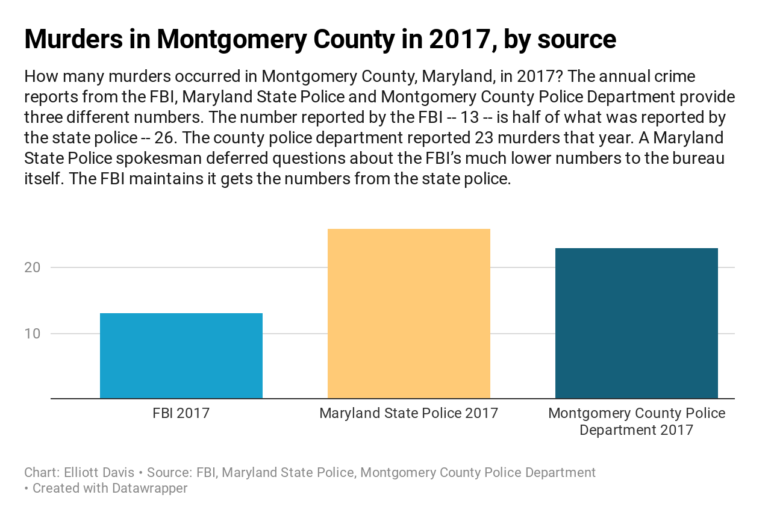By Elliott Davis
Capital News Service
The number of rapes in Maryland increased last year by 15% over the previous year, according to an annual FBI Uniform Crime Report, released Sept. 30.
This was significant — the largest year-over-year increase for the state since the FBI’s definition of rape was revised in 2013.
It’s also wrong.
In fact, many of Maryland’s crime statistics reported by government agencies are unusually inconsistent — even “astounding” and “bizarre” — according to a national crime statistics expert.
Numbers for the same crimes over the same time period in the same jurisdiction are different — sometimes markedly different — depending on which agency is reporting them: The FBI, the state police or the local law enforcement department.
In one county, for example, the FBI reported 13 people murdered; the state police listed 23 and the county, 26.
What happened to the other 10 or 13 people not included in the FBI’s report? No officials fully explained.
In fact, none of the agencies was able to fully explain how the same type of crime appeared to happen more or less often depending solely on which one reported it.
Large disparities in Prince George’s
One of the largest disparities came from Prince George’s County, where a difference of more than 100 incidents of sexual assault between the FBI and the local police department’s reports dramatically affect the overall 2018 numbers for the state.
The federal report showed that statewide, there were 200 more incidents of rape in 2018 than in 2017 — and more than 100 of those came from Prince George’s County alone.
According to the FBI, the Prince George’s County Police Department reported to them that rapes in the county had more than doubled — from 97 in 2017 to 214 last year.
But when Capital News Service contacted the county police department for a comment on this sharp increase, a spokeswoman revealed that the numbers in the FBI report are simply “wrong.”
In reality, police spokeswoman Jennifer Donelan said, the department reported 215 rapes in 2017, not 97. And there were 200 reported rapes last year in Prince George’s, not 214. Donelan said she is not sure why the FBI reported significantly different numbers at least twice.
An FBI representative told Capital News Service that the bureau “questioned” the 2017 number and “a response was received stating the questioned figures were correct.”

“The FBI works with the state (Uniform Crime Reporting) Program and does not contact the submitting agency directly,” the FBI representative said, adding that agencies submit data monthly to a “centralized repository” and bureau staff “review the information for accuracy and reasonableness.”
Greg Shipley, a spokesman with the Maryland State Police, told Capital News Service that local agencies report their crime data to the state police, which then reports the statistics to the FBI.
The FBI representative noted that the deadline for agencies to be included in the 2017 Uniform Crime Report was April 2018.
“Agencies can send missing or corrected data after the deadline; however, (Crime in the United States) will not be updated to include the new information,” the representative added, noting that any updated data will reside on the bureau’s Crime Data Explorer website.
The Prince George’s County rape data has not been publicly updated as of Dec. 23.
This reporting inaccuracy for Prince George’s County is indicative of broader examples of inconsistent crime data in the state, from the FBI to the Maryland State Police to local jurisdictions.
FBI and state police offer different reports at different times
Just as the FBI releases a Uniform Crime Report every year, the Maryland State Police releases its own annual report.
The reports are released at different times. The FBI released its 2017 report in September 2018. The Maryland State Police, however, didn’t release its 2017 Uniform Crime Report until March of this year, said spokesman Ron Snyder.
Snyder said in October that there was no timeline yet for release of the state police’s 2018 report.
With 2018 crime data from the Maryland State Police unavailable, Capital News Service reviewed the FBI, state and local police reports on violent crime from 2017 and 2016.
The numbers were anything but uniform.
The FBI reported that there were 1,691 incidents of rape in Maryland in 2017. The Maryland State Police report lists 1,773. Similarly, the FBI report shows 16,836 incidents of aggravated assault in Maryland in 2017. The number in the state police report, however, is 17,049.

The FBI also reported 23 fewer murders statewide in 2017 than the Maryland State Police did. In the 2016 reports, the FBI listed two more murders than the state police did.
The FBI representative said that with regard to the 2016 difference in murder numbers, “Because not all law enforcement agencies provide data for complete reporting periods, the FBI includes estimates for participating agencies that do not provide 12 months of complete data.”
Capital News Service was unable to discern which Maryland crime data sets the FBI had done “estimates” for and which were complete annual numbers provided by the state.
“In my opinion, estimating data or extrapolating a partial data set into a full year’s data could lead to very bad data,” said Michael Walker, an FBI adviser, and a professor at the John Jay College of Criminal Justice in New York as well as Passaic County Community College in New Jersey.
Local inconsistencies
The inconsistencies are more evident at the county level. While the Prince George’s County Police Department says that it reported 215 rapes in 2017 and the FBI lists its number for the county at 97, the Maryland State Police 2017 report says that 130 rapes were reported in that county.
These disparities among law enforcement agencies continue for other counties in the state.
The FBI’s 2017 report lists 13 murders for Montgomery County, attributed to the Montgomery County Police Department. But in the county police’s own 2017 crime report, there are 23 listed. The state police reported 26.
Shipley, with the state police, deferred questions about the FBI’s much lower numbers to the bureau itself. The FBI maintains it gets the numbers from the state police.
The numbers for murder also don’t line up for Prince George’s County. The FBI’s number in its 2017 report is 54 — attributed to the county police department — while the Maryland State Police’s number for the county in that same year is 81. This difference could be due to the FBI number not including data from other jurisdictions within the county, but Capital News Service was unable to determine why the numbers were so far apart. Crime statistics from the Prince George’s County Police itself are not immediately available — the most recent crime statistics listed on its website are from 2015.
Capital News Service requested more recent crime data from the Prince George’s department but did not receive it.
The numbers aren’t inconsistent in all places. Despite its high crime rate, figures about the city of Baltimore are relatively consistent.
The number of murders in Baltimore in 2017 and 2016 — 342 and 318, respectively — match what is reported in both the FBI and Maryland State Police data.
The number of rapes in the city in 2016 also matches up between the two reports. In 2017, the FBI lists 382 rapes in Baltimore, compared to 385 in the state police’s report.
But in Carroll County, on the other hand, the FBI lists 81 aggravated assaults from 2017, while the Maryland State Police lists 263 for the county in the same year. Shipley maintained that the difference is “likely due to the timing difference in publication.”
While some county data in the FBI’s report might contain statistics from all police jurisdictions within a given county, this is not always the case. The FBI representative told Capital News Service that the report’s county data tables do not “reflect county totals but are the number of offenses reported by the sheriff’s office or county police department.”
However, in the case of Montgomery County, the police department there reports all crime statistics from the county — including those from city police departments within its boundaries — to the Uniform Crime Reporting program, according to Shipley.
Maryland crime numbers: ‘all hell broke loose’
Walker, a statistical adviser to the FBI, said Maryland’s numbers defy nationwide norms.
“I … was somewhat startled by the differences,” he said.
Walker is a member of the FBI’s Uniform Crime Reporting subcommittee on its Advisory Process Board, which reviews policies in the bureau’s Criminal Justice Information Services. He is also a former police commissioner and has worked with the FBI’s crime data for approximately 12 years.
Provided with the FBI and Maryland State Police reports from 2017, Walker said he reviewed the data for days.
While he said there were some matches between the two reports — such as murders in Baltimore in 2017 — “all hell broke loose” in other areas.
“I’ve been running this data any which way and I can’t figure out what the differences are,” Walker told Capital News Service.
He said the differences could not be due to definitions, as the crime definitions in the state police and FBI reports are “word for word” the same.
Shipley confirmed that the agency follows “the FBI’s reporting procedure” and said he didn’t believe there is a difference in methodology.
Shipley said the differences could be tied to when the FBI releases its annual report. He said law enforcement agencies are asked to provide crime data monthly, but this “does not always occur,” which means the Maryland State Police’s annual report can be “significantly delayed” while waiting for submissions. The FBI, however, “could publish while we are still awaiting data,” Shipley noted.
“Our goal is to publish as complete and accurate a report as possible,” he added, referring to the state police’s own report.
Shipley said that 156 public safety agencies in the state submit Uniform Crime Reporting data to the Maryland State Police. The agencies are provided with spreadsheets from the FBI to fill out and submit on a monthly basis, which he said is a “fluid and ongoing process.”
“The FBI has their own schedule for publication and will publish the data they have been provided, which may not include all data ultimately received by the Maryland State Police from our state’s contributing agencies,” he said.
Shipley added that another possible reason for “number fluctuations” is a crime originally reported as an assault later being changed to a murder, which “could come months later.”
Shipley said his team is “certain of the numbers reported to and by” the Maryland State Police in its annual Uniform Crime Report.
Timing could be the issue
An FBI representative said the Crime in the United States publications provide a “snapshot” of crime.
“For example, the deadline for agencies to provide data to be included in the 2018 publication was in April of 2019,” the representative added. “Agencies have until December of 2019 to report missing or corrected data.”
Walker said timing could be the reason for the inconsistent statistics. But in his experience working with Uniform Crime Reporting data, he said, “occasionally you’ll see a minimum number of differences” in states’ numbers, but Maryland’s are “astounding” to him.
“It’s absolutely bizarre,” Walker added.
Data can affect funding
Nick Pepersack, deputy chief of staff for the Maryland Department of Budget and Management, said that funding for policing can be affected by data points in the state’s Uniform Crime Report, referring to the State Aid for Police Protection Fund formula. The fund supplements resources for police protection in Maryland communities, according to the website for the Governor’s Office of Crime Control and Prevention.
Pepersack clarified, however, that a department analyst was “not aware of any specific instances where such data points had any significant impact on a jurisdiction’s funding amount.”
Robyne McCullough, spokeswoman for the Office of Crime Control and Prevention, told Capital News Service in a written statement that the office uses the Maryland State Police’s annual report “as one of several factors used when making funding decisions.”
“We cannot speak to the methodology used to compile the FBI’s report or the results therein,” she added.
Charles Wellford, a professor emeritus in criminology at the University of Maryland, told Capital News Service that it is difficult for police departments to actually use Uniform Crime Reports for planning purposes.
“Law enforcement agencies have, for many years, little use for the Uniform Crime Reports,” Wellford said. “…They come out a year after the crime. (Police) really can’t use them for planning and strategic work.”
Wellford said this is part of the reason why the FBI and law enforcement agencies are shifting to the National Incident-Based Reporting System, which he said counts “everything that occurs in an incident.”
Currently, under Uniform Crime Reporting rules, only the “most serious” crime is counted in incidents where multiple crimes have occurred, according to Wellford.
The incident-based system was created to “improve the overall quality of crime data collected by law enforcement,” according to the FBI’s website. Fewer than half of U.S. law enforcement agencies submitted incident-based data in 2017, but the FBI has also received “thousands of commitments” from agencies saying they will be compliant by 2021, when the transition is complete.
One agency that is already using the incident-based system is the Montgomery County Police Department, the one Maryland agency certified for the system in 2017, according to staff with the FBI’s Uniform Crime Reporting program.
Melissa Schulze, a planning manager with the police, told Capital News Service that the combination of a “really old” records management system and the transition to the National Incident-Based Reporting System could be reasons why the FBI’s murder numbers for the county from 2017 are different from what the state police and department itself reported.
Sgt. Rebecca Innocenti, spokeswoman for the department, said that both incident-based and summary data were submitted that year during the transition.

Murders in Montgomery County: 13 or 14 or 23 or 26?
Capital News Service tried to focus on one narrow set of crimes — murders in Montgomery County — to try to discern how the differences happened.
The county provided a list of those murdered — naming all but one of the 23 they reported were slain in 2017. The FBI did not have names, but it provided a list of victims that included some demographic information.
Though the federal agency crime statistics said that 13 people were murdered, they provided a list of 14 victims, explaining that one death came after their initial deadline.
The state police also shared monthly numbers, but did not provide names of the 26 people they reported were murdered in the county in 2017.
Innocenti provided Capital News Service with the names of nearly all 23 people murdered within Montgomery County in 2017. (The list provided did not include the name of a person murdered in Germantown in February 2017, noting that it was an FBI case.)
The names included Laura Wallen, the pregnant Olney, Maryland, teacher whom police say was killed in early September by her boyfriend, who authorities said later killed himself in jail.
Asked which people did not make it into the FBI’s 2017 crime report, Innocenti deferred to the FBI.
The FBI representative provided a list of murders from the county in 2017 with information about the victims, including age, gender and race, but no names or dates associated with the incidents.
The FBI’s list of victims does not include someone with the same age, gender and race of Wallen.
Shipley provided Capital News Service with a list of the murder numbers the county reported to state police for the 2017 state report. He said he could not provide matching names because submitting agencies do not provide that information to the state police. The state police list also lacked any demographic information on victims, so accurate comparisons from agency to agency were not possible.
Compared to the county’s information, the Maryland State Police lists one more murder from September 2017, two more from October and one more from December. Conversely, the Montgomery County Police Department list has one more murder listed from February 2017.
Uniform Crime Reporting ‘still shows trends’
While it’s transitioning to the incident-based system, the FBI is still using the Uniform Crime Reporting summary system. Jurisdictions report their data “voluntarily,” according to Adam Wandt, a public policy professor at John Jay College.
“Some states report better than others,” said Wandt, who has experience working with Uniform Crime Reporting data.
Wandt told Capital News Service that while “discrepancies are possible” with Uniform Crime Reporting data, the statistics still have value.
“It still shows trends, even though there’s a margin for error,” Wandt said, before adding that it’s “impossible to do crime trending tracking” without such data.







Back before I retired from active blogging (2003-2015), I attempted to report all Prince Georges County homicides on my GoryPG blog. I relied on PGPD information (very difficult in the earlier years before Julie Parker was hired), press reports (from the Post and the now-defunct PG county newspapers), and the work of fellow former blogger Chris Nelson. Although the totals each year were in the same ballpark, none of the sources matched on a one to one comparison of all PG homicides. PGPD reporting was especially inconsistent when it came to counting or reporting on homicides in parks (county, state or national) or municipalities. As far as I know there is currently no reliable source for identifying ALL PG homicides in one place.